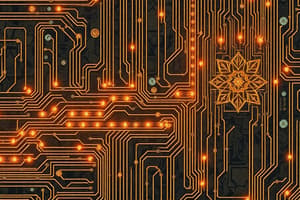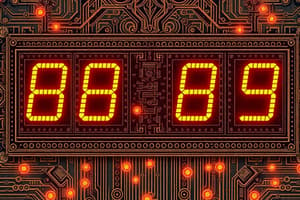Podcast
Questions and Answers
What is a primary difference between Moore and Mealy state machines regarding their output?
What is a primary difference between Moore and Mealy state machines regarding their output?
- Moore machine outputs depend only on the current state, while Mealy machine outputs depend on both the current state and input. (correct)
- Moore machines use fewer states than Mealy machines for the same functionality.
- Mealy machines are generally simpler to design than Moore machines because they don't need to consider inputs.
- Mealy machine outputs depend only on the current state, while Moore machine outputs depend on both the current state and input.
Which type of flip-flop is best suited for applications requiring minimal hardware and straightforward toggle functionality?
Which type of flip-flop is best suited for applications requiring minimal hardware and straightforward toggle functionality?
- D Flip-Flop
- SR Flip-Flop
- JK Flip-Flop
- T Flip-Flop (correct)
In the context of state diagrams, what does a transition between states typically represent?
In the context of state diagrams, what does a transition between states typically represent?
- A stable condition where the circuit remains unchanged.
- The physical layout of the circuit components.
- The power consumption level of the circuit.
- A change in input which causes the circuit to move to a different state. (correct)
Why are synchronous counters generally preferred over asynchronous counters in high-speed digital systems?
Why are synchronous counters generally preferred over asynchronous counters in high-speed digital systems?
What is the primary function of a shift register in sequential logic circuits?
What is the primary function of a shift register in sequential logic circuits?
In the context of sequential circuits, what is the purpose of a 'state table'?
In the context of sequential circuits, what is the purpose of a 'state table'?
Which of the following best describes the 'race condition' in asynchronous sequential circuits?
Which of the following best describes the 'race condition' in asynchronous sequential circuits?
What is a 'glitch' in an asynchronous sequential circuit?
What is a 'glitch' in an asynchronous sequential circuit?
What benefit do synchronous counters offer over asynchronous designs?
What benefit do synchronous counters offer over asynchronous designs?
Why is understanding the characteristics of 'racing' and 'glitches' particularly important when designing asynchronous circuits?
Why is understanding the characteristics of 'racing' and 'glitches' particularly important when designing asynchronous circuits?
Why might a designer choose to implement a Mod-N counter using asynchronous rather than synchronous techniques?
Why might a designer choose to implement a Mod-N counter using asynchronous rather than synchronous techniques?
What characteristics distinguish a 'Ring' counter from other types of counters?
What characteristics distinguish a 'Ring' counter from other types of counters?
How does a JK flip-flop differ from an SR flip-flop in its operation?
How does a JK flip-flop differ from an SR flip-flop in its operation?
In a state diagram, what do the circles and arrows typically represent?
In a state diagram, what do the circles and arrows typically represent?
Why are preset and clear inputs important in many practical flip-flop circuits?
Why are preset and clear inputs important in many practical flip-flop circuits?
How does the 'up-down' counter provide both increasing and decreasing count sequences?
How does the 'up-down' counter provide both increasing and decreasing count sequences?
When designing a sequential circuit, why might the designer choose to implement a D flip-flop over other types?
When designing a sequential circuit, why might the designer choose to implement a D flip-flop over other types?
Why is proper termination important when using shift registers for high-speed data transmission?
Why is proper termination important when using shift registers for high-speed data transmission?
What considerations are most important to take into account when deciding between using different counter ICs, such as IC7493 or IC74161, in digital circuit design?
What considerations are most important to take into account when deciding between using different counter ICs, such as IC7493 or IC74161, in digital circuit design?
Flashcards
Moore Machine
Moore Machine
A sequential circuit whose outputs depend only on the current state, not the current inputs.
Mealy Machine
Mealy Machine
A sequential circuit where outputs depend on both the current state AND the current inputs.
Latch
Latch
A basic storage element that can store one bit of information. It changes state when its input changes.
Flip-Flop
Flip-Flop
Signup and view all the flashcards
State Diagram
State Diagram
Signup and view all the flashcards
State Table
State Table
Signup and view all the flashcards
Shift Register
Shift Register
Signup and view all the flashcards
Synchronous Counter
Synchronous Counter
Signup and view all the flashcards
Racing
Racing
Signup and view all the flashcards
Glitches
Glitches
Signup and view all the flashcards
Asynchronous Counters
Asynchronous Counters
Signup and view all the flashcards
Study Notes
- Sequential Logic circuits involve Moore and Melay Machines
- Latches and Flip-Flops (SR, JK, T, D) are types of sequential logic circuits
- Sequential logic circuits use State Diagrams, Timing Diagrams, and state Tables
- Sequential Circuit Design involves Shift Registers and Synchronous counters (up, down, up-down, Ring)
- Counter IC examples: IC7493, IC74161
- Asynchronous Sequential Logic circuits exist
- They have characteristics such as Racing and Glitches
- Asynchronous Counters include (up, down, Mod-N)
Studying That Suits You
Use AI to generate personalized quizzes and flashcards to suit your learning preferences.




